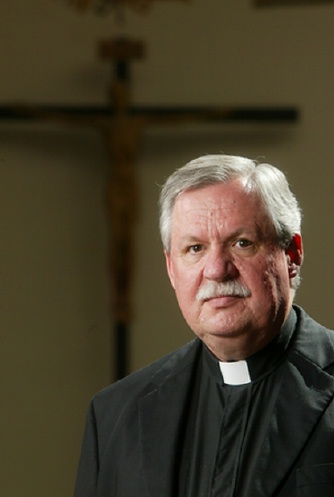
At the crucifixion, according to the Gospel of John, we find Jesus’ Mother and the Beloved Disciple standing at the foot of the cross (John 19:25b). This scene presents us several essential themes.
First, recall that in the Gospel of John the Beloved Disciple is never given a name. Why no name? The author of the Gospel may have wanted us each to realize that we are Jesus’ Beloved Disciples. Remember at the Last Supper Jesus says that his followers are his friends, not his servants (John 15:15). So, we stand as friends, the Beloved Disciples of Jesus, at the foot of the cross.
Second, Jesus on the cross gives his Mother into the Beloved Disciple’s care. “Woman, here is your son…Here is your mother…” (John 19:26ff). So, not only do we stand at the cross as his friends, but we also stand with his Mother, whom he has given into our care.
Third, in the first chapter of the Gospel, John the Baptist says twice as Jesus approaches, “Behold the Lamb of God who takes away the sins of the world.” The crucifixion (John 19) occurs just at the time when the lambs were being slain in the Temple for the Passover, underlining the Baptist’s early prediction that Jesus is the Lamb that was slain.
Fourth, “But when (the soldiers) came to Jesus and saw that he was already dead, they did not break his legs. Instead, one of the soldiers pierced his side with a spear, and at once blood and water came out” (John 19:33-34).
In Catholic tradition this is the moment at which the Church is born. Notice how these four themes merge in this scene: the Son – the Lamb of God – who has died for his Beloved Disciples and is being raised to new life by the Father; the Mother of God given into the care of the Beloved Disciples who are the friends and followers of Jesus; and Jesus’ body broken and his blood poured out for us, his friends.
These Eucharistic symbols – Jesus the Lamb of God (John 1), the bread of life and his blood as living food (John 6), the Living water (John 7), the community of Beloved Disciples gathered at this place and time with his Mother – were present at the crucifixion and are present at every Eucharist as the realities of Christ’s Passion, Death and Resurrection.
In Catholic tradition the Church is the Body of Christ. The Church is the People of God. And the Church is most visible when the People of God are gathered for the Eucharist. Catholic tradition bases this teaching on the scene at the crucifixion. As we gather for the Eucharist we relive that scene with all its saving power, the power of his Real Presence at the center of his people, the Church, who are sustained as well by his Blessed Mother.
“Christ has died. Christ is risen. Christ will come again!”

No comments:
Post a Comment